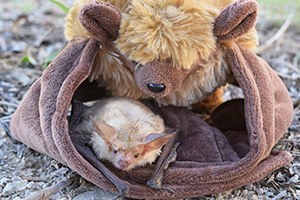Predicting Desert Wildflower Blooms - The science behind the spectacle
by Mark Dimmitt, Director of Natural History
Desert annual wildflower blooms are nearly impossible to predict for two reasons:
- The necessary conditions are not precisely known;
- Many interacting variables affect the phenomenon.
What we do know:
Spring-blooming annuals must germinate in the autumn. This is a crucial fact that most people don't know. The "critical window" is probably between late September and early December, but differs with different species. The controlling environmental factor is temperature.
A "triggering rain" of at least one inch must occur during this autumn window, the earlier the better after summer heat has waned. Rains at other times will seldom trigger germination of the showy-flowered species.
The triggering rain must be followed by regular rains totaling at least an inch per month through March, a season total of at least five inches, seven or eight are better. In short, a really good wildflower bloom requires both an unusually early and an unusually wet winter rainy season. The rains must also be well spaced. Spectacular, widespread shows occur about once in 10 years in the Sonoran and Mohave Deserts. Good or better displays occur in localized areas perhaps every three or four years; these may be in remote regions and go unnoticed.
However, even when all the above conditions are met, the bloom may be mediocre or poor. And occasionally a good bloom occurs when the above conditions appear not to have been met. The latter can happen when an unusually warm rain triggers germination in winter, but the short growing season usually precludes a really good show. Factors which are suspected of preventing a show include:
- a few weeks of warm, windy weather; the water stress triggers premature flowering;
- a cold winter that retards growth of the seedlings;
- high population levels of herbivores such as rodents, rabbits, quail, or insects;
- a wet preceding summer, resulting in thick growth of summer vegetation, which in turn prevents germination of winter annuals.
When it does happen, the peak typically lasts only two weeks at a given location, sometime between late February and mid April. Most often it happens in early to mid March.
Furthermore, only certain areas ever have mass displays; soil type and vegetation cover are important factors. The rocky and densely-vegetated Tucson Mountains rarely if ever have mass blooms, whereas Picacho Peak and the Tohono O'odham (Papago) Indian Reservation do fairly regularly.
The above information pertains only to annual wildflowers (poppies, lupines, owl clover, etc.) Perennials are less fussy about the timing of rainfall. Thus a late but wet rainy season can still produce good blooms of penstemon, larkspur, brittlebush, etc. Some plants such as palo verdes, ocotillo, and most cacti flower every year regardless of rainfall. (See Desert Flowering Seasons for details.) But it is the annuals alone that produce the desert's famous carpets of color.










